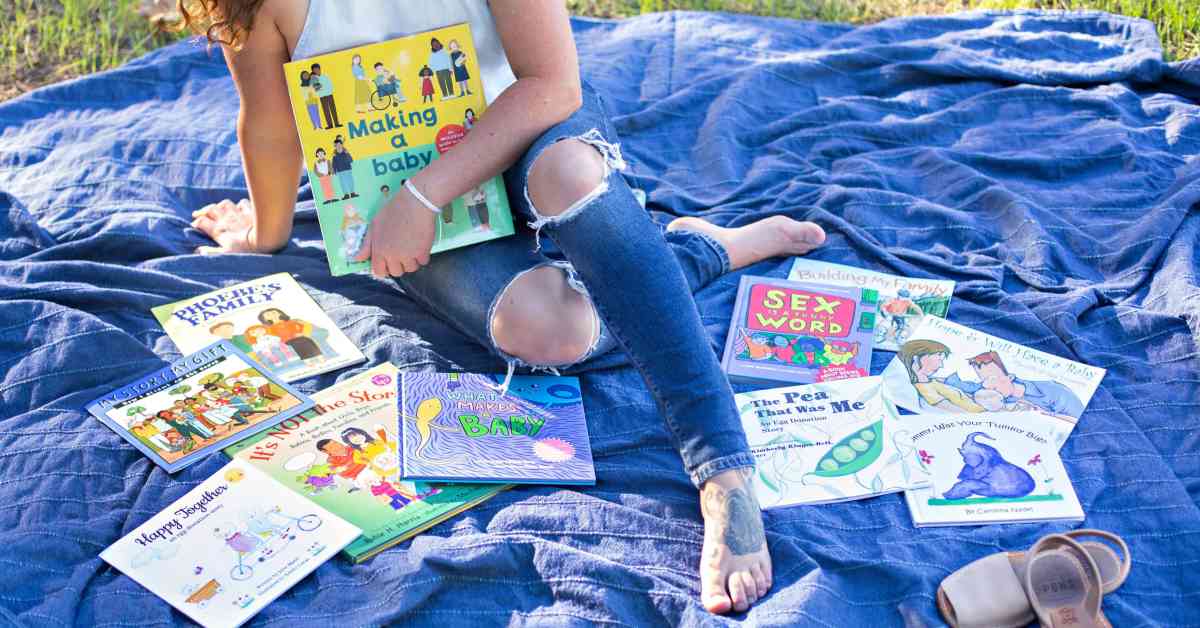Telling your child how they were conceived is one of the most important, valuable things that you can do for your child. Doing so “early and often,” as research suggests, can lead to better emotional outcomes, especially for donor conceived children. In this piece, I’ve taken the time to review children’s books on 3rd Party Conception and list the criteria that I believe is important when telling these stories to little ones. This list is my own and meant to serve as a starting place when looking for books to purchase on this sensitive topic. If you choose and love other books, great! The most important thing is that you are finding a way to share your childs’ conception story with them. It is a starting place that your child, and family, can develop into a bigger, more complex story as time unfolds.
While there are various children’s books that explain conception via donor gametes and embryos, as well as surrogacy, many of them are done poorly.
Reading and talking about this complex topic should be as easy and comfortable for parents as possible. Having to explain away incorrect parts of a book or spending additional time researching exactly HOW marsupial babies are born just adds stress to what should be a celebration of life.
Below is a comprehensive guide on how to select a children book that aids in telling your child about their unique conception story. I’ve also included a list of books that I highly recommend, based on such criteria.
What to Look For
- Use of proper terminology for reproductive organs and cells including gametes, egg/eggs/ova/ovum, sperm, uterus, embryo, fetus, etc.
- Inclusivity. Representation of various family types such as LGBTQ+, interracial couples, single parent families, disabled individuals, etc. While it’s important to see families like your own, children must also understand the different ways in which other families are created. This not only affirms your family’s narrative but creates a space for empathy and understanding of other family types.
- Prompts directed discussion about your family’s unique conception story, including specific information known about your gamete or embryo provider and/or surrogate.
- Factually correct content and illustrations. For example, all parts of a sperm are present, showing the development of an embryo, that kangaroos are born after 28 days gestation and navigate to the pouch to continue growing for 8 months, etc. Facts matter.
- Engaging, well done illustrations: Bright colors, hard lines, whimsical, realistic, consistent styling, etc.
- Books on conception, bodies and families, in general. Having general knowledge on the topic, in an easy, age appropriate way to digest for a young child, can aid in telling your own family conception story.
What to Avoid
- Indirect and inaccurate language: “Seed” instead of sperm. “Tummy” instead of uterus or abdomen.
- Making assumptions about a gamete or embryo provider, or surrogate’s character. While these people may have done something that helped people become parents (verb), it cannot be assumed that this person is “helpful” or “kind” (adjective). Language like this paints a picture that may be inaccurate and could lead to disappointment when your child learns about or meets them in the future.
- Making jokes. This is a very sensitive, important subject and adding humor is completely unnecessary, dismissive and harmful.
- Inaccurate content and illustrations. This includes sperm without a tail, illustrating and describing egg and sperm as dancing and illustrating ova to look like chicken eggs.
- Poor illustrations. For example, pencil outline being present in the final product, copy and pasted famous art in a background, and digital print on a garment when the rest of the book is manually illustrated.
- Illustrations that have literally nothing to do with the content of the book. You Began as a Wish is a lovely, inclusive story (even without gender assumptions) but the illustrations show children that babies just fall from the sky – how terrifying (and irrelevant)!
- A book that’s only purpose is to convey just how much their baby was wanted. Yes, a parent’s biggest dream is a major piece of the puzzle but it tends to overshadow how the child feels about being born into the world in this way. It’s important to explore how children feel, and address any questions they might have, as part of telling their story.
Special Consideration When Choosing Books
Anthropomorphizing: During the Piaget’s Pre-operational stage of development, ages 2-7, children enjoy books that include talking animals and animated machines,* so anthropomorphization in children’s books for this age group are developmentally appropriate. Therefore, it could be appropriate to have a children’s book on conception that includes a family of rabbits, bears or kangaroos.
However, this could be entirely problematic if handled in a way that conveys incorrect information, such as in the case of Linda Stamm’s book, Phoebe’s Family: A Story About Egg Donation. An otherwise wonderful book on the subject, anthropomorphized eggs and sperm are shown literally dancing together – Eggs and sperm DO NOT DANCE to create an embryo.
Another example, from The Pea That Was Me: An Egg Donation Story, includes misinformation even in the context of anthropomorphization; Kluger-Bell attempts to anthropomorphize a pea, which might be an embryo, and it goes horribly wrong.While several illustrations are inaccurately depicted and include factually incorrect information, Kluger-Bell’s biggest faux pas includes a written and illustrated pea that grows into a baby then “grows into a boy or girl.” This negates the chromosomal sex of a child, as well as the children’s gender. All of Kluger-Bell’s books are clumsy and incompetent. Anthropomorphizing for convenience, in this manner, is negative and should be avoided at all cost.
Other books that I reviewed included animal families with no problems in anthropomorphization. The books, with animal families, that didn’t make the cut had faults that were unrelated to anthropomorphization. Such as: inaccurately explaining how kangaroos are born and develop, and misrepresenting an egg and sperm as puzzle pieces that fit together.
Third Party Reproduction Books I Recommend
Making a Baby
By Rachel Greener & Clare Owen
“An INCLUSIVE guide to how every family begins.”
Please note that this book contains content and an illustration of vaginal intercourse.
It’s NOT the Stork! A Book about Girls, Boys, Babies, Bodies, Families, and Friends
Written by Robie H. Harris & Illustrated by Michael Emberley
Ages 4 and up. Please note that this book describes vaginal intercourse, without illustrations.
What Makes a Baby
Written by Cory Silverberg & Illustrated by Fiona Smyth
“A book for every kind of FAMILY and every kind of KID”
This is a general book about how babies are made. It does not describe IVF or intercourse but does describe and illustrate vaginal and cesarean delivery. Especially wonderful for trans and non-binary parents, as gender is not assumed.
Building My Family: A Story of Egg Donation & Surrogacy
Written by Carrie Eichberg, Psy.D. & Illustrated by Elizabeth Parkinson
Our Story: How We Became a Family
Written by Nina Barnsley & Stephanie Clarkson, Illustrated by Gabi Froden
Published by Donor Conception Network
-The book I reviewed included two dads, and donor egg, and a surrogate. Donor Conception Network has stories for every family. **
Happy Together: an egg donation story **
Written by Julie Marie & Illustrated by Ashley Lucas
-Books about other families available as well.
Sophia’s Broken Crayons: A Story of Surrogacy from a Young Child’s Perspective
Written by Crystal Falk & Edited by Kathea Smith
From the Start
Written by Stephanie Levich & Alana Weiss, Illustrated by Darren Gate
-A concise, inclusive book about how families are made via IUI and IVF, donor gametes, surrogacy and adoption. This book does not include embryo donation.
Books That Didn’t Make The Cut
The Pea That Was Me
by Wendy Kluger-Bell [Every book in this series] By Kimberly Kluger-Bell, LMFT
The Pea That Was Me… and Me… and Me! (How All Kinds of Babies Are Made)
Written by Kimberly Kluger-Bell, LMFT & Illustrated by Ros Webb
The Kangaroo Pouch: A Story About Surrogacy for Young Children
Written by Sarah A. Phillips & Illustrated by Laurie A. Faust
Phoebe’s Family: A Story About Egg Donation
Written by Linda Stamm & Illustrated by Joan Clipp
A Tiny Itsy Bitsy Gift of Life: An Egg Donor Story
Written by Carmen Martinez Jover & Illustrated by Rosemary Martinez
You Began as a Wish
Written by Kim Bergman, PhD & Illustrated by Irit Pollak
The Very Kind Koala: A Surrogacy Story for Children
by Kimberly Kluger-Bell, LMFT
Mommy, Was Your Tummy Big?
By Carolina Nadel
Hope & Will Have a Baby: The Gift of Egg Donation
Written by Irene Celcer & Illustrated by Horacio Gatto
Closing Thoughts About Children’s Books on Third Party Reproduction
Remember, books are tools. They open doors to more meaningful conversations in which children can explore fantasies and emotions, and learn. These books turn into narratives that your children will hold onto for decades. Make the conversation around the book meaningful.
I’m Here to Help!
Whether you have a quick question about this topic, or you would like therapeutic support on your journey, you may send me a quick email or schedule a free 15 minute consultation directly on my website.
*Source: Owlcation: Child Development Theories in Children’s Literature
**Tip for parents: Use “sperm” instead of “seed” when reading these books.
I do not utilize affiliate links on my website. External links are provided for convenience.



